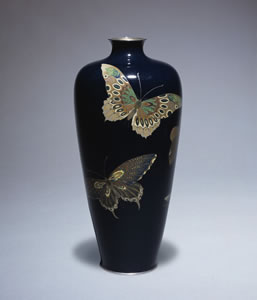The characters used for Shippo, the Japanese term for enamels, are a reference to the Seven Treasures mentioned in Buddhist texts. The Japanese applied this term to the rich colours found on Chinese enamels and to those made later by Japanese craftsmen.
The art of cloisonné enamelling was, following the ‘reopening’ of the country in the 1850s, one of Japan’s most successful forms of manufacture and export of the late 19th century. The peak of artistic and technological sophistication was between 1880 and 1910, a period referred to as the ‘Golden Age’, and a time when the taste for Japan in the West was at its height and museums were avidly acquiring Japanese art from dealers and international exhibitions.
The combining of the V&A’s historical collection of Japanese enamels (including pieces from the Paris International Exposition of 1867, the earliest documented examples of Japanese cloisonné enamels in any world collection) with the recent Edwin Davies Gift of cloisonné enamels now enables us to present a rounded picture of one of Japan’s most exquisite art forms to a wider national and international audience. |

Vase_Nagoya, mark of Hayashi Kodenji, c.1880-90 |


